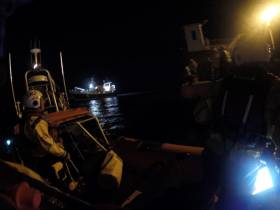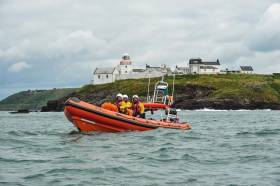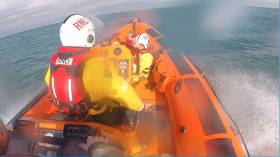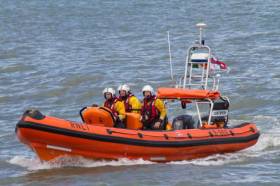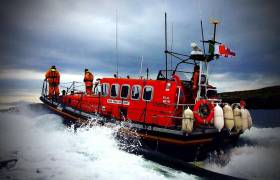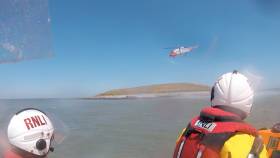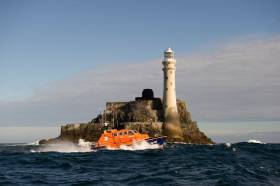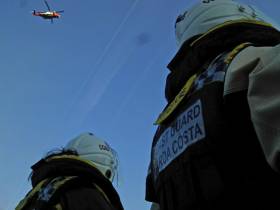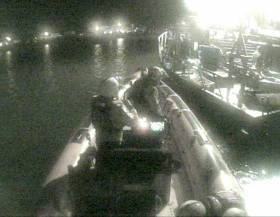Displaying items by tag: Skerries
Weekend Callouts For Arklow & Skerries Lifeboats To Fishing Vessels In Difficulty
#Lifeboats - Arklow RNLI’s all-weather lifeboat crew left their Sunday lunch on 23 September to attend to a fishing vessel in difficulty east of Cahore Point in Co Wexford.
Once the vessel and its crew of three were located, it was established that while it had power, it could not make any headway due to its propeller being fouled with fishing gear.
The lifeboat volunteers rigged a tow line and set up for a long slow tow home to Arklow. All hands came ashore safely some five hours later.
Mark Corcoran, community safety officer at Arklow RNLI, said: “We would like to remind people to respect the water and always wear a lifejacket and carry a means of calling for help when going out on the water.”
The previous evening, Skerries RNLI was tasked to another fishing vessel which suffered mechanical failure and lost engine power less than half a mile north of Skerries harbour.
The struggling 22m fishing boat, with a crew of seven on board, was well lit and visible from the shore so the Atlantic 85 lifeboat Louis Simson made its way quickly alongside.
With the fishing vessel drifting dangerously close to the shore, it was decided to establish a tow to bring safely alongside the harbour.
Speaking about the callout, volunteer lifeboat press officer Gerry Canning said: “This was quite a large vessel for us to take under tow, but the conditions were very fair on the night and the Atlantic 85 was very much up to the job.”
Crosshaven Lifeboat Launched To Angling Boat Aground On Black Rock
#RNLI - While on exercise yesterday afternoon (Sunday 2 September), the volunteer crew Crosshaven RNLI overheard a radio transmission to the coastguard explaining that a 23ft angling boat was aground on Black Rock near Whitegate oil refinery in Cork Harbour.
As it happened, the lifeboat was close by and immediately responded to the angling boat, with two persons on board, which had run hard aground.
Trying to tow the vessel would have caused damage. Instead, the crew were taken off and an anchor set on the casualty boat before it reflected on the next high tide. The anglers were then transferred to Aghada Pier.
The callout came just a day after Crosshaven’s lifeboat volunteers launched on a medevac to a Belfast angler bitten by a blue shark off Roches Point.
Elsewhere, Skerries RNLI rescued a man and two children on Saturday evening (1 September) after their motorboat suffered mechanical failure.
Skerries RNLI were tasked after Dublin Coast Guard received a 999 call from a member of the public that there were an adult and two children in difficulty in a personal watercraft off the south strand in Skerries.
The volunteer crew launched their Atlantic 85 Inshore lifeboat Louis Simson and made their way towards the area indicated by the caller.
Once on scene, the crew began a quick search of the area and quickly ascertained that the vessel in difficulty was in fact a small motorboat rather than a personal watercraft.
The boat had suffered mechanical failure and was unable to make their way ashore. A tow was set up and the boat was brought safely back to the slipway in Skerries. Conditions at the time were fair with a force one to two southerly breeze.
“It was great to see everyone on board the vessel wearing good lifejackets,” said Skerries RNLI press officer Gerry Canning. “Also, the person who called it in wasted no time in dialling 999 and asking for the Coast Guard once they spotted someone in trouble.
“It’s great to see that people are taking the safety messages on board and are all playing their part in helping us save lives at sea.”
Skerries Lifeboat Rescues Teen Paddle Boarder Blown Out To Sea
#RNLI - Hours after rescuing a family of five from their grounded yacht, Skerries RNLI launched to the aid of a teenager blown out to sea on a stand-up paddle board yesterday evening (Tuesday 14 August).
Skerries RNLI was tasked along with the Dublin-based Irish Coast Guard helicopter Rescue 116 after a 999 call from a member of the public reporting a person in the water off Gormanston beach who appeared unable to get back to shore.
The volunteer crew in Skerries launched their Atlantic 85 inshore lifeboat Louis Simson and proceeded directly to the Gormanston area. The rescue helicopter arrived on scene just before the lifeboat and was able to pinpoint the casualty’s location.
There were two people clinging to the paddle board when the lifeboat arrived: a teenage male who was in difficulty, and an experienced sea swimmer who swam out to the teenager in order to assist him and keep him calm.
The crew helped both people on board and then took the paddle board into the lifeboat. The swimmer was insistent that he was okay and asked to be dropped to shore. However, he had been in the water for a considerable amount of time and was very cold.
It was decided that the best course of action would be to bring him back to the lifeboat station, where the lifeboat was greeted by Skerries RNLI honorary medical Officer Dr Seamus Mullholland and an awaiting ambulance, both of whom had been called as a precaution.
The teenager was treated for symptoms of mild hypothermia and monitored closely for a period of time before he was reunited with his mother by the Skerries Coast Guard unit.
Speaking about the callout, Skerries RNLI volunteer lifeboat press officer Gerry Canning said: “The young man in this case was caught out by a sudden change in the conditions. Thankfully he was wearing a lifejacket and someone on shore knew to dial 999 and ask for the coastguard.
“And while we would recommend that you never enter the water to help someone, we would like to thank the swimmer who assisted the boy for keeping him calm and encouraging him to stay with his board until help arrived.”
The incident came hours after the Skerries lifeboat rescued a French family of five from their yacht that ran aground at the town’s harbour, as previously reported on Afloat.ie.
Family Of Five Rescued In Skerries After Yacht Runs Aground
#RNLI - A family of five were rescued by Skerries RNLI in the early hours of this morning (Tuesday 14 August) after their yacht ran aground at the North Co Dublin town’s harbour.
As RTÉ News reports, the family, who are understood to be French nationals, sent a Mayday after their vessel broke its moorings.
The Skerries lifeboat crew were quickly on scene and retrieved the family — two adults and three children aged 12 to 16 — in a dinghy.
RTÉ News has more on the story HERE.
#RNLI - Clifden RNLI’s all-weather lifeboat was launched on Tuesday evening (17 July) for the medevac of a young woman who sustained a serious head injury in a cycling accident on Inishbofin.
Arriving at the island’s harbour at 8.53pm, lifeboat crew members Joe Acton and Daniel Whelan met the island nurse, carried out an assessment and then transferred the casualty, a visitor to the island, on board.
The lifeboat proceeded to Cleggan where an ambulance was waiting to transfer the casualty to University College Hospital Galway. The crew continued to monitor her condition throughout the crossing.
“The casualty in this case was certainly in need of urgent medical treatment and we were glad to have been able to help to transfer her quickly to the mainland,” said Clifden RNLI coxswain James Mullen.
“The summer population of Inishbofin increases massively due to tourism and as a result these sorts of situations while rare can arise. The presence of the RNLI all-weather boat in the area has certainly helped for these kinds of incidents.”
Earlier in the week, the Clifden all weather boat had been launched to another medical emergency in the island but stood down after the coastguard helicopter reached the scene first.
Elsewhere on Tuesday evening, Skerries RNLI were tasked to a motorised RIB that had suffered electrical failure north of Lambay Island.
Shortly after 9pm the Atlantic 85 inshore lifeboat launched with Joe May at the helm and crewed by Sheila May, AJ Hughes and Jack Keane.
As the lifeboat neared the island, the casualty vessel fired a white parachute flare to alert of their whereabouts in fading light.
The vessel, with four men and one woman on board, was taken under tow by the lifeboat and returned to the safety of Rush Harbour.
“Thankfully we were able to locate the casualty quickly and all on board were well and in good spirits,” said Skerries RNLI volunteer lifeboat press officer Gerry Canning.
“Our volunteers are always ready to respond and we would always advise anyone going to sea to carry more than one means of contacting the shore, and, if needed, to make the call for help early.”
#RNLI - Skerries RNLI launched yesterday afternoon (Tuesday 3 July) shortly after 1.30pm after a motorboat with two on board called the coastguard via VHF radio to report they were taking on water near Rockabill Lighthouse.
The lifeboat was launched with volunteer Philip Ferguson at the helm and Emma Wilson and Joe May as crew, ensuring that they had loaded the salvage pump aboard.
They proceeded in the direction of Rockabill and quickly had the stricken boat in sight. Once on scene, they transferred the salvage pump and began pumping water from the boat as they continued to head towards Skerries Harbour.
Dublin’s Irish Coast Guard helicopter Rescue 116 had also been tasked and was soon on scene and standing by.
There was a concern that the salvage pump being used may run out of fuel before the casualty reached Skerries. After communications with the helicopter, it was decided to transfer an additional pump.
The safest method of doing this in the prevailing conditions was to transfer the pump, along with a winchman, to Colt Island, where the lifeboat then picked it up and brought it to the casualty.
Once both pumps were operational, the lifeboat and helicopter escorted the vessel to the safety of Skerries Harbour. Skerries Coast Guard then secured the Red Island landing site for Rescue 116 to touch down and recover their winchman.
The incident came less than 24 hours after the Skerries lifeboat was tasked to a kayaker struggling to get back on board his craft.
Lifeguards on the South Beach in Rush alerted the coastguard on Monday afternoon (2 July) that a kayaker had entered the water and appeared to be having difficulty getting back on board. Skerries RNLI were tasked and the volunteers launched their Atlantic 85 inshore lifeboat, with Joe May at the helm and crew Eoin Grimes and Sheila May.
As the lifeboat approached Rush beach, they liaised directly with lifeguards who were able to guide them directly to the casualty.
Just before the lifeboat arrived, the man had managed to get back on his kayak and had begun to make his way ashore. The lifeboat crew spoke to the man and he assured them that despite being tired, he was happy to make his own way ashore. He was met at the shoreline by the lifeguards who offered him assistance.
Speaking after both callouts, Skerries RNLI volunteer lifeboat press officer Gerry Canning said they were “a great example of how well the different organisations work together. It’s also showed the difference it can make having the right equipment, and making the call for help as early as possible.”
Baltimore Lifeboat Launches To Broken Down Trawler
#RNLI - Baltimore RNLI were called out in the early hours of yesterday morning (Friday 23 March) to a fishing trawler with five people on board which had broken down close to shore.
The volunteer lifeboat crew launched their all-weather lifeboat at 5.20am after the Irish Coast Guard requested assistance for a 22m fishing trawler that had suffered engine failure close to the shoreline off the West Cork harbour’s mouth.
Arriving on scene six minutes later, the lifeboat found the casualty vessel had an anchor shot and the crew, all in lifejackets, were working to resolve their mechanical difficulties. Weather conditions at the time had a south-westerly Force 5 wind and a 1.5m sea swell with good visibility.
Within 20 minutes, the trawler was underway by its own power, under escort of the Baltimore lifeboat, to the safety of Baltimore Harbour.
Speaking following the callout, Baltimore RNLI volunteer lifeboat press officer Kate Callanan said: “If your boat is in danger close to the shoreline, always remember to try not to panic.
“Use the resources available such as deploying an anchor, ensure all people aboard are in lifejackets and seek assistance as soon as possible. If you get into difficulty at sea or on the coast, call 999 or 112 and ask for the coastguard.”
The volunteer crew on this callout were coxswain Kieran Cotter, mechanic Cathal Cottrell, Pat Collins, Davie Ryan, Colin Whooley, Aidan Bushe, Emma Lupton and Don O’Donovan. Sean McCarthy assisted at Baltimore lifeboat station.
Elsewhere on the Irish coast, Skerries RNLI launched to reports of individuals in distress on two separate occasions earlier this week.
Shortly after 4am on Monday morning (19 March), Skerries volunteers launched their Atlantic 85 inshore lifeboat after Dublin Coast Guard received a call that a person in distress had entered the water near Laytown.
The lifeboat, with Emma Wilson at the helm and crewed by Steven Johnson, JP Tanner and Paddy Dillon, had just launched the boat when they were stood down as a garda had managed to help the person ashore to a waiting ambulance.
The lifeboat launched again on Tuesday evening (20 March) shortly after 11.30pm, this time helmed by Peter Kennedy with volunteers Jack Keane, JP Tanner and Paddy Dillon on board.
Concerns had been raised about a person who was in danger of entering the water near Bettystown. Again the lifeboat was stood down shortly after launching as shore-based emergency services had taken the person into their care.
Speaking about the callouts, Skerries RNLI volunteer lifeboat press officer Gerry Canning said: “It’s been a restless start to the week for our volunteers, but they are always ready to answer any call for help.
“The most important thing is that there wasn’t a tragic outcome in either case and we hope that the casualties make a full and speedy recovery.”
DPP Directs No Prosecution Over Fatal Razor Clam Boat Capsize
Investigations have concluded and no prosecution will be directed by the DPP over the death of a fisherman off Skerries last summer, as the Irish Examiner reports.
Garda divers recovered the body of Jamie McAllister (28) on 27 May 2017, close to where the razor clam boat he had been working on with his uncle sank the previous day.
The inquest into the incident is now adjourned for full hearing on Thursday 1 November.
#RNLI - Clogherhead and Skerries RNLI rescued a man whose fishing boat got into difficulty north of Dublin Bay yesterday afternoon (Thursday 1 February).
The volunteer crews were requested to launch the all-weather lifeboat from Clogherhead and the inshore lifeboat from Skerries at around 1pm after a request from the Irish Coast Guard to assist the skipper of a 10m fishing vessel, which had got into difficulty four-and-a-half miles northeast of Skerries.
The vessel had lost engine power while on passage from Kilmore Quay to the Shetland Islands.
Skerries RNLI was first on the scene, and after assessing that no one was in immediate danger, they worked with the skipper to take the fishing boat under tow.
With winds from the northwest gusting up to 30 knots at the time and seas up to three metres high, a decision was made due to the weather conditions to transfer the tow line to the Clogherhead all-weather lifeboat.
The fishing vessel was then successfully towed into Skerries Harbour and tied up at 2pm.
Speaking following the callout, Clogherhead RNLI volunteer lifeboat press officer Gerry Kelly said it was “a fine example of RNLI volunteers from neighbouring stations working well together to help bring someone to safety.
“We would remind anyone going to sea, regardless of their activity, to always respect the water. Always wear a lifejacket and always carry a means of calling for help and keep it within reach.”
Skerries Lifeboat Assists Razor Fisherman With Steering Issues
#RNLI - Skerries RNLI assisted a 12-metre razor fishing vessel that developed steering problems near Loughshinny last night (Friday 17 November).
Shortly before 9pm, one of the volunteer crew raised the alarm after receiving a phone call from a fisherman on the razor boat, stating that it had fouled its rudder.
The Skerries RNLI volunteers launched their lifeboat with Conor Walsh at the helm and crew Joe May, Steven Johnson and JP Tanner.
The lifeboat located the casualty vessel, with one man on board, near Loughshinny Harbour and proceeded to tow the boat safely back into the harbour.
Weather conditions at the time was calm with a Force 1 to 2 westerly wind.
Speaking about the callout, Skerries RNLI lifeboat press officer Gerry Canning said: “It was a cold and dark night for our volunteers to be out, thankfully they were able to resolve the situation very quickly.
“This kind of thing can happen to anyone at any time, but the RNLI are always ready to respond to a call for help.”


























